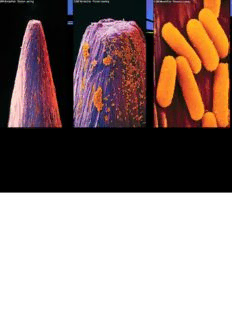
Marine Bacteria and Archaea PDF
Preview Marine Bacteria and Archaea
100 µm 0.5 µm 20 µm Marine Bacteria and Archaea Metabolic diversity • Organisms have two fundamental nutritional needs: • 1. Obtaining carbon in a form that can be used to synthesize fatty acids, proteins, DNA, and RNA • Autotrophs get their carbon from CO 2 • Heterotrophs get carbon from organic sources vs 2 Metabolic diversity • Organisms have two fundamental nutritional needs: • 2. Acquiring chemical energy in the form of ATP • Phototrophs: energy from light • Lithotrophs (or Chemotrophs): energy from inorganic chemicals such as H S, ammonia NH , methane CH 2 3 4 • Organotrophs: energy from organic sources, such as sugars 3 Metabolic diversity Category Energy source Carbon source Hydrogen or Examples electron source Photolithoautotrophy Light CO Inorganic Cyanobacteria, 2 purple sulfur bacteria Photoorganoautotrophy Light Organic compounds Organic compounds Purple non-sulfur or H bacteria, aerobic, 2 anoxygenic bacteria, archaea (?) Chemolithoautotrphy Inorganic CO Inorganic Sulfur-oxidizing 2 bacteria, nitrifying bacteria, archaea Chemoorganoautotrophy Organic Organic compounds Organic compounds Wide range of compounds bacteria and archaea Mixotrophy (combination Organic Organic compounds Inorganic Sulfur-oxidizing of lithoautotrophy and compounds bacteria organoheterotrophy) Evolution of life Prebiotic Precellular Early Evolutionary LUCA chemistry life cellular life diversification 4.3-3.8 bya 3.8-3.7 bya Biological RNA Protein DNA Lipid Divergence of building blocks world synthesis bilayers Bacteria and Archaea Amino acids Catalytic RNA RNA – Replication Cellular Components of DNA Nucleosides Self-replicating RNA templated Transcription compartments replication, Sugars translation Early cells likely transcription, and had high rates translation all in of HGT place Submarine mounds and their possible link to the origin of life. Model of the interior of a hydrothermal mound with hypothesized transitions from prebiotic chemistry to cellular life depicted Differences between Archaea, Bacteria and Eukaryotes Characteristic Bacteria Archaea Eukaryotes Cell type Prokaryotic Prokaryotic Eukaryotic Histones No histones Have proteins Have histones similar to histones Introns No introns Some introns Most contain introns Ribosome size 70S ribosomes 70S ribosomes 80S ribosomes Cell wall Peptidoglycan Made of protein Not always present composition (lack peptidoglycan) Plants: cellulose plasma membrane Fungi: Chitin Cell membrane Ester linked lipids Ester linked lipids Ester linked lipids composition with D-Glycerol with L-Glycerol with proteinf (straight chain) (branch chain) (straight chain) Themes: Growth & reproduction by fission A. Bacterium before B. DNA replication starts. C. The new copy of DNA DNA replication. It proceeds in two is attached at a Bacterial chromosome is directions membrane site near the attached to the plasma parent DNA molecule. membrane. E. Deposits of new F. The ongoing deposition D. New membrane grows membrane and new wall of membrane and wall between the two material extend down material divides the cell in attachment sites. into the cytoplasm. two. Themes: conjugation nicked plasmid conjugation tube A. A conjugation tube forms between a B. DNA replication starts on the nicked donor and a recipient cell. An enzyme has plasmid. The displaced DNA strand moves nicked the donor’s plasmid. through the tube and enters the recipient cell. C. In the recipient cell, replication starts on D. The cells separate from each other; the the transferred DNA. plasmids circularize.
Description: